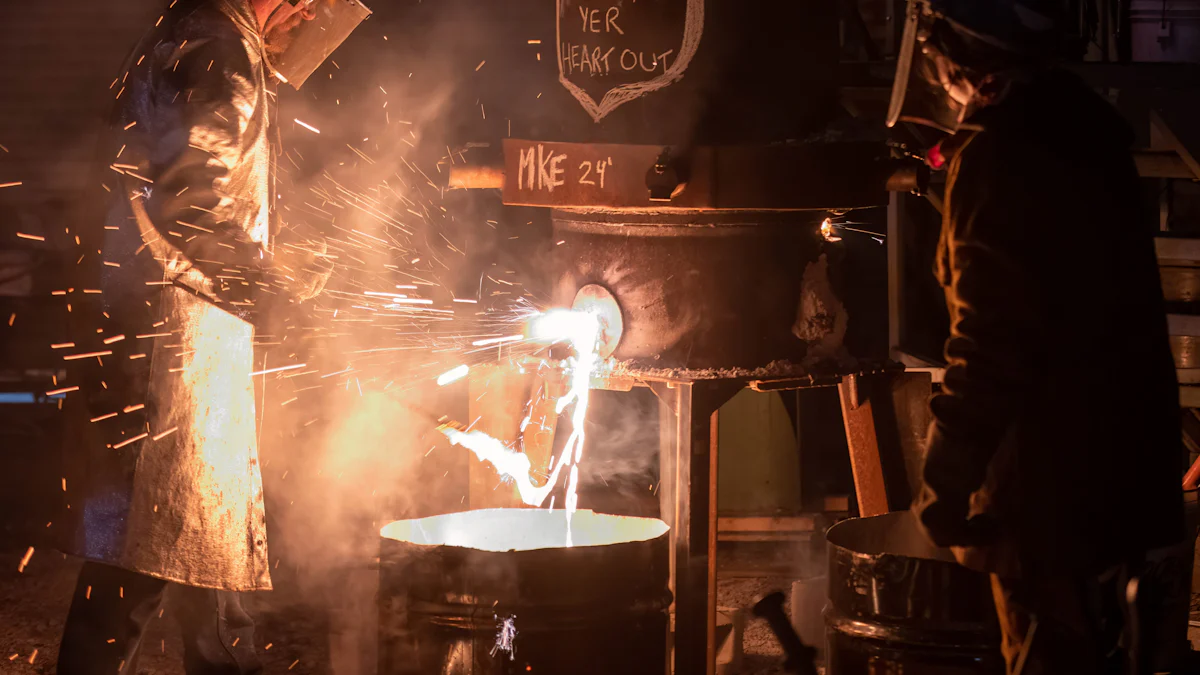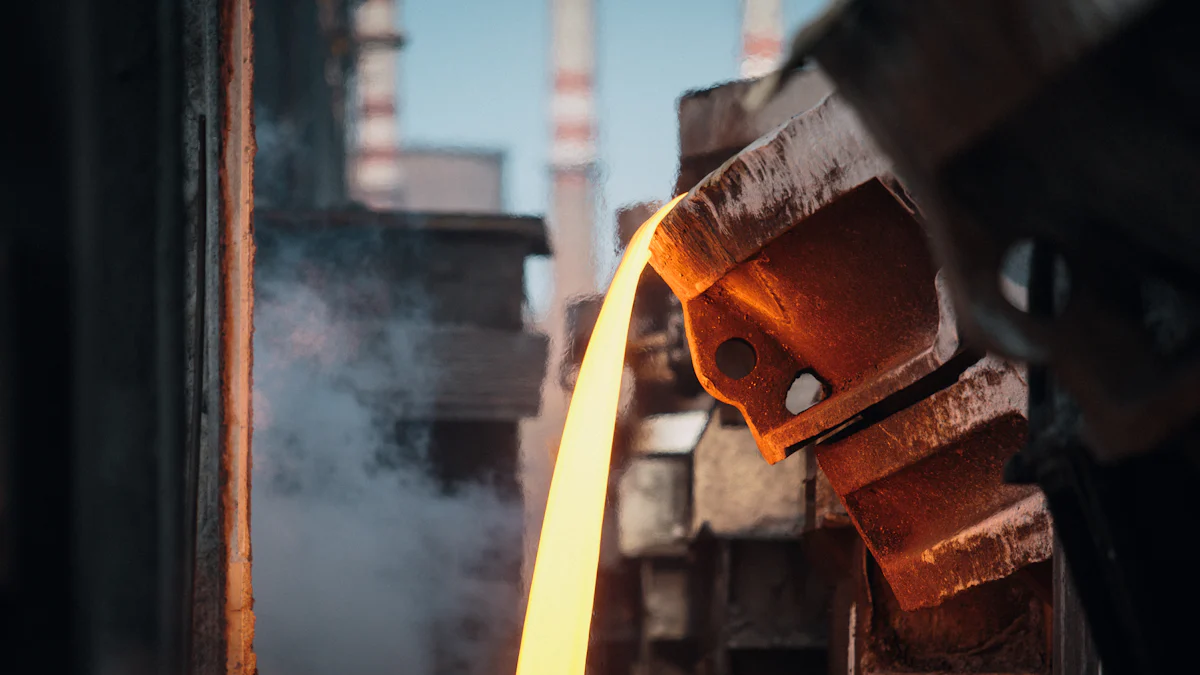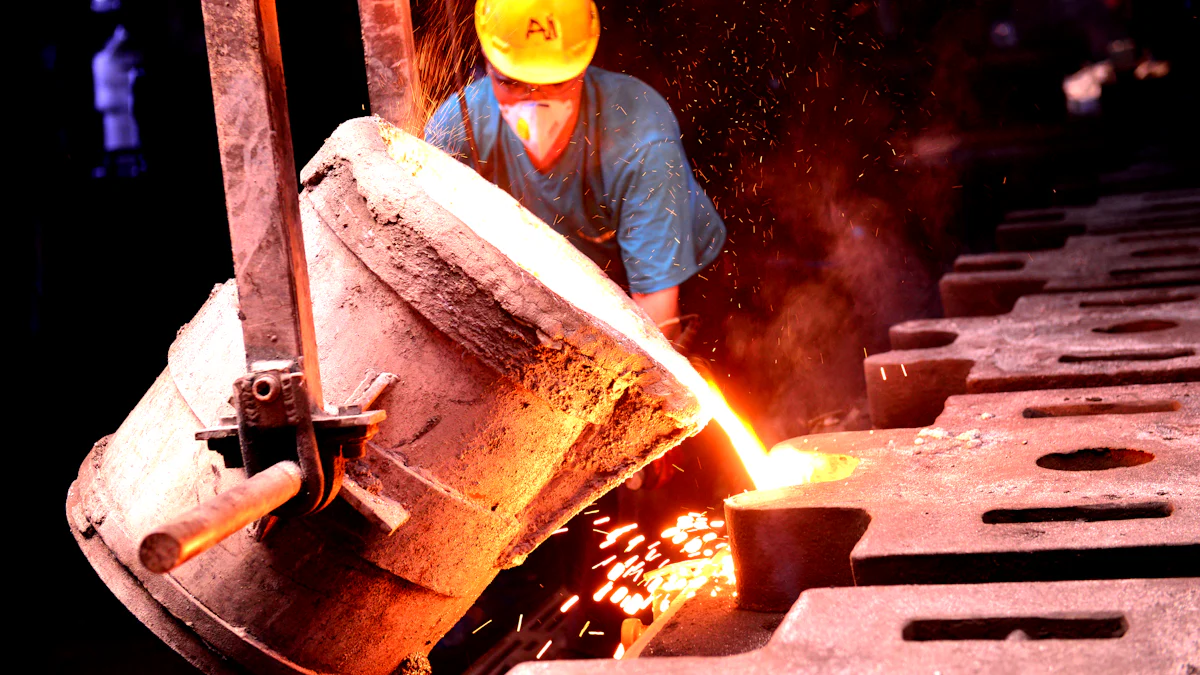
Choosing between powder metallurgy vs casting depends on understanding their distinct processes and outcomes. Powder metallurgy compacts metal powders below the melting point, ensuring high material efficiency and precision. In contrast, casting melts metal to form parts but may require trimming. Recognizing these differences between powder metallurgy vs casting ensures optimal performance, cost-effectiveness, and suitability for specific applications.
Overview of Powder Metallurgy

Definition and Process
Powder metallurgy is a manufacturing process that creates metal parts by compacting metal powders into a specific shape and then heating them to form a solid piece. This process involves four key steps. First, metal powders are produced through methods like atomization or chemical reduction. Next, these powders are mixed and blended to achieve the desired composition. The third step, compaction, uses high pressure to shape the powder into a mold. Finally, the sintering process heats the compacted part below its melting point to bond the particles and enhance strength. This method has evolved significantly since its origins in ancient civilizations, where the Incas used metal powders to craft jewelry. Modern advancements have made it a cornerstone of precision manufacturing.
Key Advantages
Powder metallurgy offers several advantages that make it a preferred choice in many industries. It allows for the production of precise, complex parts with minimal waste. Unlike casting, this process eliminates the need for draft angles, enabling intricate designs and better material utilization. Manufacturers can also alter the final properties of parts by adjusting the powder composition. Automation further enhances efficiency, reducing labor costs and ensuring consistent quality. Additionally, powder metallurgy often skips finishing processes, saving time and resources. Its cost-effectiveness, especially for large production runs, makes it a competitive alternative to machining.
- Minimal waste and material costs
- Ability to produce intricate shapes
- Customizable material properties
- Reduced need for secondary finishing
- High potential for automation
Common Limitations
Despite its benefits, powder metallurgy has limitations. The size of parts is restricted by the capacity of the presses, making it unsuitable for large components. Achieving consistent density during compaction can be challenging, leading to variations in part quality. Additionally, parts produced through this method generally lack the strength and ductility of cast or forged components, limiting their use in high-stress applications. Powder metallurgy can also be cost-inefficient for small production runs due to high initial setup costs.
- Size limitations due to press capacity
- Density variations during compaction
- Reduced strength and ductility compared to casting
- High costs for small production volumes
When comparing powder metallurgy vs casting, these limitations highlight the importance of selecting the right process based on project requirements.
Overview of Casting

Definition and Process
Casting is one of the oldest manufacturing techniques, with roots tracing back to ancient Mesopotamia around 4000 BC. Over time, it has evolved into a highly versatile process used across industries. At its core, casting involves transforming raw materials into finished parts by melting and shaping them. The process follows these steps:
- Melting: The material is heated in crucibles until it becomes molten, which also helps remove impurities.
- Molding: A mold is prepared to define the shape of the final product. This step includes selecting the mold material and ensuring it hardens properly.
- Pouring: The molten metal is carefully poured into the mold cavity.
- Casting Cleaning: Once the metal cools and solidifies, residual materials are removed.
- Finishing Treatments: Techniques like sanding or painting enhance the product’s appearance and functionality.
- Inspection: The final product undergoes quality checks to ensure it meets structural and design requirements.
This process has stood the test of time due to its adaptability and ability to produce intricate designs.
Key Advantages
Casting offers several benefits that make it a popular choice for manufacturing. Its design flexibility allows for the creation of complex geometries, making it ideal for intricate components. The process supports a wide range of metals and alloys, enabling manufacturers to tailor material properties to specific needs. Additionally, casting is cost-effective due to its low tooling costs, as molds can be made from inexpensive materials. These advantages make casting a reliable option for both small and large-scale production.
- Design flexibility for intricate shapes
- Compatibility with various metals and alloys
- Cost-effective tooling
Common Limitations
Despite its strengths, casting has limitations that must be considered. The process often requires a high initial investment in durable equipment and tools. It is also limited to metals with lower melting points, restricting material options. Casting defects, such as porosity or shrinkage during solidification, can compromise the final product’s quality. Dimensional inaccuracies may arise, necessitating additional finishing work to achieve the desired surface finish. These challenges highlight the importance of careful planning when choosing casting for a project.
- High initial equipment costs
- Limited material variety due to melting point restrictions
- Risk of defects like porosity and shrinkage
- Additional finishing work often required
When comparing powder metallurgy vs casting, these limitations emphasize the need to align the manufacturing process with the project’s specific requirements.
Detailed Comparison of Powder Metallurgy vs Casting
Quality and Precision
When comparing the quality and precision of powder metallurgy vs casting, powder metallurgy stands out for its superior dimensional accuracy and surface finish. Powder metallurgy achieves tolerances as tight as ± 0.04 mm, while casting often struggles with lower precision due to mold filling dynamics. The microstructure in powder metallurgy is more uniform, resulting in consistent mechanical properties. In contrast, casting faces challenges like porosity and segregation, which can compromise quality.
| Factor | Powder Metallurgy | Casting |
|---|---|---|
| Dimensional Accuracy | Achieves ± 0.04 mm | Generally lower accuracy |
| Mechanical Properties | More uniform microstructure | Issues with segregation and porosity |
| Surface Finish | Roughness Average (Ra) of 1.6 µm | Typically coarser finish |
Material Properties and Strength
The material properties in powder metallurgy vs casting differ significantly. Powder metallurgy offers better control over microstructure, allowing for finer and more consistent properties. It also minimizes internal defects, ensuring higher material efficiency. Casting, however, often suffers from issues like air trapping and shrinkage, which can lead to non-uniform properties.
| Factor | Powder Metallurgy | Casting |
|---|---|---|
| Mechanical Properties | More uniform microstructure, consistent properties | Issues like segregation and porosity can affect properties |
| Material Efficiency | Consistent weight and density, fewer internal defects | Non-fills and internal defects due to air trapping |
| Dimensional Accuracy | High accuracy due to controlled compaction | Variability due to mold filling dynamics |
| Control over Microstructure | Greater control, ability to form finer structures | Cooling rate affects microstructure |
Cost and Efficiency
Powder metallurgy and casting differ in cost efficiency. Powder metallurgy requires higher initial equipment investment but compensates with reduced labor needs and minimal secondary operations. Its high material utilization rate, around 95%, minimizes waste. Casting, while having lower tooling costs, often demands extensive finishing work, increasing overall expenses. Powder metallurgy also achieves faster production times due to streamlined processes.
- Powder metallurgy equipment is expensive but offers high production efficiency.
- Sintered parts require fewer secondary operations compared to cast pieces.
- Powder metallurgy minimizes waste with a material utilization rate of 95%.
- Dimensional accuracy and surface finish in powder metallurgy reduce the need for additional processing.
Suitability for Complex Geometries
Powder metallurgy excels in creating intricate shapes and complex geometries. Its design flexibility allows for features like controlled porosity, which casting cannot achieve. Casting, on the other hand, faces limitations due to the need for draft angles and parting lines, making it less suitable for highly detailed designs.
- Powder metallurgy supports intricate features and complex shapes.
- Controlled porosity is achievable in powder metallurgy but not in casting.
- Casting requires draft angles and parting lines, limiting design flexibility.
Environmental Impact and Sustainability
Powder metallurgy is more environmentally friendly than casting. It consumes less energy, uses recycled materials, and generates minimal waste. The process achieves a material utilization rate of 95%, significantly reducing scrap. Casting, however, consumes more energy and produces higher waste levels, contributing to a larger environmental footprint.
| Process Type | Energy Consumption | Material Waste | Environmental Impact |
|---|---|---|---|
| Powder Metallurgy | Less energy | Less waste | More environmentally friendly |
| Traditional Casting | More energy | More waste | Higher environmental impact |
Applications Across Industries
Powder metallurgy and casting serve diverse industries. Powder metallurgy is widely used in automotive, aerospace, and medical sectors for precision parts like gears, turbine disks, and surgical tools. Casting finds applications in construction, marine, and defense industries, producing components like engine blocks, lamp posts, and military equipment.
- Powder Metallurgy Applications:
- Automotive: Lightweight sintered parts for fuel efficiency.
- Aerospace: High-temperature-resistant turbine disks.
- Medical: Surgical tools and dental implants.
- Casting Applications:
- Construction: Lamp posts and drainage pipelines.
- Marine: Stainless steel and aluminum alloy components.
- Defense: Durable parts for military vehicles and firearms.
Understanding the differences between powder metallurgy and casting is essential for selecting the right manufacturing process. Powder metallurgy excels in precision, material efficiency, and automation, while casting offers flexibility for larger parts and diverse materials. Factors like cost, material properties, and application play a critical role in decision-making:
- Equipment costs and production efficiency vary significantly.
- Material properties determine the suitability for specific performance needs.
- Applications influence the choice based on part complexity and size.
Aligning the process with project-specific needs ensures optimal results. Powder metallurgy supports intricate designs and controlled porosity, while casting accommodates larger, simpler geometries. By evaluating these factors, you can confidently choose the process that best meets your goals.
FAQ
What is the main difference between powder metallurgy and casting?
Powder metallurgy compacts metal powders into shapes, while casting melts metals to fill molds. Each process suits different applications based on precision and material properties.
Which process is more cost-effective for large-scale production?
Powder metallurgy is more cost-efficient for large runs due to minimal waste and automation. Casting may incur higher costs from finishing and material inefficiencies.
Can both processes handle complex geometries?
Powder metallurgy excels in intricate designs with controlled porosity. Casting supports complex shapes but requires draft angles, limiting its flexibility for highly detailed parts.
